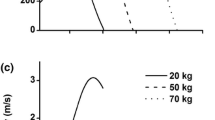Summary
1. The purpose of the experiment was to examine how force, speed and power output of horizontal pulling with the upper limb was affected by the height of pull. 2. Fourteen seated male subjects made horizontal pulls with maximal effort at eye, shoulder and elbow level from their positions of full reach when the trunk and shoulder girdle were rigidly constrained. 3. Dynamic pulls were performed against a water-filled viscous dynamometer in which the resistance, proportional to the square of the velocity, could be varied. 4. The height of pull had no significant effect on either static or dynamic performance. 5. A force-velocity-position surface is presented which describes the conditions at the handle during the pulls. It confirms the importance of degree of reach upon the dynamic performance, and over a greater range of velocities than has been studied previously. 6. A simple model shows that the similarity of performance at eye, shoulder and elbow heights is remarkable because they occur under very different biomechanical circumstances. 7. The total work done in a complete pull increases with resistance. Peak power output is obtained against the same resistance (50 kg m−1) that was reported for elbow flexion and standing pulls.
Similar content being viewed by others
References
Assmussen E, Hansen O, Lammert O (1965) The relation between isometric and dynamic muscle strength in man. Communication No. 20 of the Testing and Observation Institute, Hellerup, Denmark: Danish National Association for Infantile Paralysis
Cavanagh PR, Grieve DW (1970) The release and partitioning of mechanical energy during a maximal effort of elbow flexion. J Physiol (Lond) 210:44–45
Dempster WT (1955) Space requirement of the Seator Operator. Wright Air Development Center Report 55-195, Wright Patterson Air Force Base, Ohio
Dern RJ, Levene M, Blair HA (1947) Forces exerted at different velocities in human arm movements. Am J Physiol 151:415–437
Grieve DW (1984) The influence of posture on power output generated in single pulling movements. Appl Ergonom 15:115–117
Hill AV (1940) The dynamic constants of human muscle. Proc R Soc Biol (Lond) 128:262–274
Hunsicker PA (1955) Arm strength and selected degrees of elbow flexion. Wright Air Development Center Report, 54-548, Medical Laboratory, Wright Patterson Air Force Base, Ohio
NASA (1978) Anthropometric Source Book, vol. I. Anthropometry for designers. National Aeronautics and Space Administration Publication 1024. Scientific and Technical Information Office. Staff of Anthropology Research Project (ed). Webb Associates, Yellow Spring, Ohio
Wilkie DR (1950) The relation between force and velocity in human muscles. J Physiol (Lond) 110:249–280
Author information
Authors and Affiliations
Rights and permissions
About this article
Cite this article
Grieve, D.W., van der Linden, J. Force, speed and power output of the human upper limb during horizontal pulls. Europ. J. Appl. Physiol. 55, 425–430 (1986). https://doi.org/10.1007/BF00422745
Accepted:
Issue Date:
DOI: https://doi.org/10.1007/BF00422745




